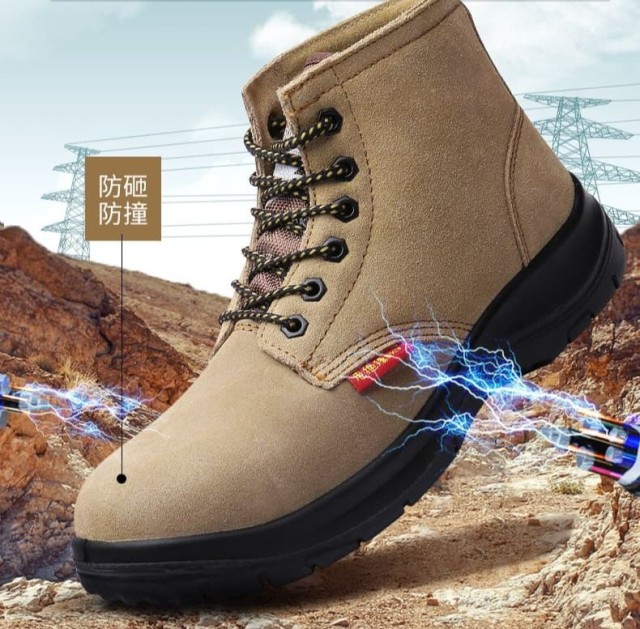Electrical hazard (EH) safety boots are critical for workers exposed to live circuits, high-voltage equipment, or static discharge risks. This guide breaks down the material science behind their protection, compliance standards, and real-world applications—helping safety managers and procurement specialists make informed decisions.
Electrical Hazard Safety Boots: Beyond Basic Protection
Workplace electrical injuries cause approximately 1,000 fatalities annually in industrial sectors. EH-rated boots act as the last line of defense when other controls fail. Unlike standard safety footwear, they:
- Block current flow using non-conductive soles and shanks
- Eliminate metal components (e.g., composite toe caps replace steel)
- Mitigate static buildup through insulated materials
Case Example: A utility lineman’s EH boots prevented fatal electrocution when accidental contact occurred with a 7,000V line—demonstrating how material choices directly save lives.
Material Science: Why Leather and Rubber Are Non-Conductive
Key Properties of EH-Compliant Materials
-
Natural Rubber Outsoles
- Resist electricity up to 18,000 volts (per ASTM F2413 testing)
- Provide flexibility without conductive additives
-
Full-Grain Leather Uppers
- OSHA-mandated for durability and non-conductivity
- Unlike synthetic fabrics, won’t melt when exposed to sparks
-
Composite Toe Caps
- Fiberglass or carbon fiber alternatives to conductive steel
- Meet impact protection (75 ft-lbs) without electrical risk
Did You Know? Some advanced blends incorporate silica-treated rubber to enhance slip resistance while maintaining dielectric properties.
Safety Standards Decoded: ASTM, ISO, and OSHA Requirements
ASTM F2413-18 EH Standard Breakdown
- Voltage Resistance: Minimum 14,000V AC / 20,000V DC insulation
- Component Restrictions: No exposed metal in shanks, eyelets, or fasteners
- Labeling: Must display "EH" shield and ASTM standard code
OSHA Compliance Essentials
Employers must provide EH footwear when workers:
✔ Handle live wires or equipment over 50V
✔ Work in wet conditions with electrical tools
✔ Face static discharge hazards (e.g., flammable vapor areas)
Pro Tip: Combine EH boots with arc-flash rated PPE for comprehensive protection.
Real-World Applications: Case Studies from Heavy Electrical Industries
Utility Sector
A Midwest power company reduced electrical incidents by 40% after switching to EH boots with:
- Dielectric testing every 6 months
- Kevlar® liners for puncture resistance near substations
Manufacturing Plants
An automotive parts supplier eliminated static-related product defects by:
- Issuing anti-static EH boots to assembly line staff
- Implementing conductive flooring zones
Maintaining Protection: Durability and Testing Protocols
3-Part Inspection Routine
- Daily: Check soles for cracks compromising insulation
- Monthly: Verify tread depth >1/8" for grounding
- Annually: Professional dielectric testing
Critical Note: EH properties degrade if boots are exposed to oils, extreme temperatures, or physical damage.
Trust 3515 for Your Electrical Hazard Footwear Needs
As a leading manufacturer with decades of expertise, 3515 crafts EH safety boots that balance compliance, comfort, and cutting-edge protection. Our bulk production capabilities ensure consistent quality for distributors and industrial clients worldwide.
Ready to upgrade your safety program? Partner with us for footwear solutions engineered to mitigate electrical risks while meeting your operational demands.
Related Products
- Wholesale Customizable Suede Safety Boots - Puncture-Proof with Velcro Closure
- Wholesale Customizable Safety Boots Durable & Protective Footwear Manufacturing
- Durable Mid-Cut Tactical Boots for Wholesale & Private Label
- Wholesale Durable Breathable Safety Boots Custom OEM Manufacturer
- Durable Leather Safety Boots for Wholesale & Custom OEM Manufacturing
Related Articles
- How to Choose Work Boots That Balance Safety, Comfort, and Durability for Your Job
- How to Choose Work Boots That Match Your Job's Safety Demands
- How to Extend Work Boot Lifespan: Science-Backed Care for Safety & Savings
- How to Choose Work Boot Materials for Maximum Safety and Durability
- How to Choose Work Boots That Match Your Industry's Safety Needs















